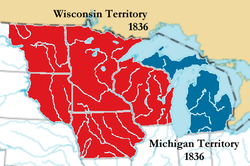Wisconsin Territory
The Wisconsin Territory was a historic territory of the United States that existed between 1836 and 1848. It was created by a law passed by the United States Congress , which President Andrew Jackson signed on April 20, 1836, and which came into effect on July 3, 1836. Belmont , Wisconsin was originally designated as the territory's capital, but was replaced by the current capital, Madison , in October 1836 .
After the separation of the Iowa Territory in 1838, the remaining eastern part of the Territory became the State of Wisconsin . He joined the Union on May 29, 1848 as the 30th state .
Territorial area
The Wisconsin Territory included the current states of Wisconsin, Minnesota , Iowa, and part of North Dakota and South Dakota north of the Missouri River . Much of the territory was originally part of the Northwest Territory of 1787, which was formally ceded to the Kingdom of Great Britain in 1814 . The part that now corresponds to Iowa and the Dakotas were originally part of the Louisiana Purchase , with which France ceded its Louisiana colony to the United States in 1803 . These were split off from the Missouri Territory in 1821 and annexed to the Michigan Territory in 1834 .
The area of the later Wisconsin Territory was added to the Indiana Territory when this - in preparation for the admission of Ohio as a state - was detached from the Northwest Territory in 1800. In 1809 it was split off from the Indiana Territory and annexed to the Illinois Territory . When Illinois became a state in 1818, the area was annexed to the Michigan Territory. When Michigan became a state in 1836 , the western part of the previous Michigan Territory was split off under the name of Wisconsin Territory. This was finally reduced in size in 1838 with the establishment of the Iowa Territory . The current state of Wisconsin encompasses most of the then remaining Wisconsin territory. The remainder of the territory was officially dissolved and merged with the Minnesota Territory in 1849 .
history
President Andrew Jackson named Henry Dodge Governor and John S. Horner Minister. The first parliamentary assembly of the new territory was convened on October 25, 1836 by Governor Henry Dodge in Belmont, Lafayette County , Wisconsin.
The Wisconsin Territory separated from the Michigan Territory in 1836 as Michigan was preparing to join the Union. However, there are certain irregularities with regard to the timing. Congress had rejected Michigan's petition to establish a state over the simmering dispute over the Toledo Strip , despite the fact that the area of 86,000 people had more than the 60,000 required by the Northwest Ordinance . As a result, Michigan wrote its own constitution in October 1835 and began to govern itself. On July 3, 1836, Congress separated the Wisconsin Territory from the Michigan Territory, but it was not until January 26, 1837 that Michigan was admitted as a state into the union.
Acting Michigan Territory Governor Stevens T. Mason called on August 25, 1835 for the election of a western legislative assembly to meet on January 1 in Green Bay , Wisconsin, in hopes of doing so during this transition period to be able to provide some continuity in governance. But on August 15, 1835, Mason had been removed from office by President Jackson because of the conflict over the Toledo Strip, better known as the Toledo War . John S. Horner was his successor. As one of his first official acts, Horner issued his own proclamation on November 9, 1835, which the council convened on December 1, 1835. This gave the delegates less than a month to learn about this change and to get to this meeting in time. This caused considerable anger among the delegates, who therefore ignored this call. The assembly, known as the Rump Council , therefore met as planned on January 1, 1836 in Green Bay. Horner, however, who had supposedly wanted to come, was late because of an illness, so that in the absence of the governor the council meeting could do little more than the administrative and ceremonial duties.
Michigan had to give way in the dispute over the Toledo Strip. To compensate, Michigan received the upper peninsula .
See also
Individual evidence
- ↑ Wisconsin (territory)
- ↑ History of Wisconsin - Chapter 2 - Wisconsin as a Territory ( Memento of October 12, 2008 in the Internet Archive )


